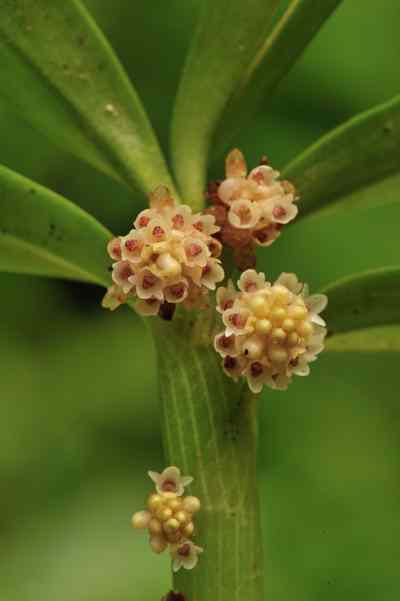The Plant
Terrestrial. Whole plant 12 to 18 cm high with sender stem. Leaves sub-equal, 3 to 4 in number with the middle ones the largest, elliptic, narrowed to the base, stalkless, 3 to 5 cm long and less than 1.5 cm in width. Spike narrow than the stem, about 7 to 10 cm long. Tubers oblong to cylindric.
The Flower
Flowers in a narrow spike, small, laxly arranged. Sepals sub-equal, linear; lateral pair pointing upwards, dorsal arching. Petals as long as the lateral sepals, connivent with the dorsal sepal. Lip longer than the sepals and petals, three lobed. The middle segment linear, slightly shorter but broader than the lateral ones; lateral pair filiform and spreading with upward curving edges. Spur longer than the lip but shorter than the erect ovary, variable in shape – clavate or fusiform, curved. Floral bract lanceolate and slightly shorter than the ovary, clasping.
The whole flower is green in colour.

The Pursuit
A small plant of the region. Even though King and Pantling mentioned this plant in their monumental work, somehow I missed it. I can’t even remember an instance of reading its descriptions from the reference book.
I was camping in a sub-tropical forest at an altitude between 4800 to 6000 ft in the monsoon season of 2012. I had a long list of plants that required searching almost everyday. My team and me worked every day 8 to 10 hours in the region, walking around 25 to 30 km. On one Sunday, I was making a casual survey around 11:30 Hrs and was walking downhill on a narrow trek road to the village. The trek road was on the side of a cliff with tall bamboo forest on the cliff side and a small stream about 40 ft down on the other side. The trek road was hardly of 3 ft in width, hence going up and down that way needs at-most caution. As I was walking downhill, a group of children of an uphill village were returning to their homes after attending prayers at the village church. They were all in colourful and bright dresses. Their colourful dress along with the dark monsoon clouds in the horizon prompted the artist within me to take a few photographs of them. The children were so excited that they were posing in different animated ways. I was aware of the stream on the side of the trek road and to avoid anybody accidentally falling down, asked them to climb up the bamboo forest to have some photo shoots. As I wanted the dark monsoon clouds in the background, I asked few of them to climb a rock inside the bamboo forest, so that I can have a low angle shot with clouds in the background. I was looking for a good position to kneel down for the low angle without destroying any plants on the ground. Then I stumbled upon four specimens of this species in full bloom next to the rock. I was surprised to see those plants, at the same lucky that none of the children who walked in front of me stepped on them. Since I was unable to remember the illustrations of the species from the referral book, I was not able to identify it instantaneously. As the children had to reach their homes before the rains, I first took their photos and then concentrated on the new find.
As the flowers were in full bloom, I was unaware of its identity. I made detailed drawings and took several photographs from all possible angles in order to establish its identification. I was documenting the four plants for long time and was unaware of the looming rain clouds. Finally, as the rain started pouring down I packed up my camera bag and started walking back to my camp.
While back at the camp, I found out from King and Pantling’s work the identity of the plant. I thanked the Almighty, those children and the rain clouds for that wonderful find of that day. The next Sunday, I cancelled all my programs and waited for those children with my pocket full of toffees. The only thing which was not there was the “heavenly blessings” – the rain and the rain clouds.
Reference:
King, G. & Pantling, R. (1898). The Orchids of the Sikkim-Himalayas. Ann. Roy. Bot. Garden.(Calcutta). Habenaria aristata Hook., Page no 312.


